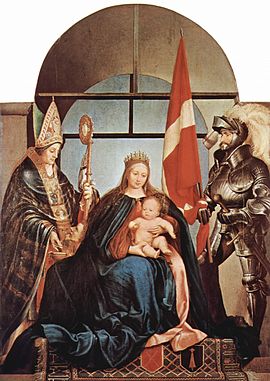Solothurn Madonna
- View a machine-translated version of the German article.
- Machine translation, like DeepL or Google Translate, is a useful starting point for translations, but translators must revise errors as necessary and confirm that the translation is accurate, rather than simply copy-pasting machine-translated text into the English Wikipedia.
- Consider adding a topic to this template: there are already 9,148 articles in the main category, and specifying
|topic=will aid in categorization. - Do not translate text that appears unreliable or low-quality. If possible, verify the text with references provided in the foreign-language article.
- You must provide copyright attribution in the edit summary accompanying your translation by providing an interlanguage link to the source of your translation. A model attribution edit summary is
Content in this edit is translated from the existing German Wikipedia article at [[:de:Solothurner Madonna]]; see its history for attribution. - You may also add the template
{{Translated|de|Solothurner Madonna}}to the talk page. - For more guidance, see Wikipedia:Translation.
| Solothurn Madonna | |
|---|---|
 | |
| Artist | Hans Holbein the Younger |
| Year | 1522 |
| Medium | Oil on limewood |
| Dimensions | 143,5 cm × 104,9 cm (565 in × 413 in) |
| Location | Kunstmuseum Solothurn, Solothurn |




The Solothurn Madonna is an oil-on-panel painting executed in 1522 by the German-Swiss artist Hans Holbein the Younger in Basel. It shows the Virgin Mary and Christ enthroned, flanked by Martin of Tours (shown as a bishop giving alms to a beggar) and Ursus of Solothurn (shown as a soldier in armour). Holbein used his wife Elsbeth as his model for the Madonna, and the baby "may well have been modelled on Holbein and Elsbeth's baby son Philipp."[1]
The church which originally commissioned it is unknown,[2] but it resurfaced in 1864 in poor condition in the Allerheiligenkapelle in the Grenchen district of Solothurn. It has been owned by the town of Solothurn since 1879, and it has been named after the town since the late 19th century. It is kept in the Solothurn Art Museum. After the Darmstadt Madonna, the Solothurn Madonna is the second largest surviving Madonna by Hans Holbein the Younger.
See also
References
Bibliography (in German)
- Jacob Amiet: Hans Holbein's Madonna von Solothurn Und der Stifter Nicolaus Conrad, Solothurn, 1879. Reprint: Bibliolife, LaVergne, 2011.
- Oskar Bätschmann, Pascal Griener: Hans Holbein d.J. – Die Solothurner Madonna. Eine Sacra Conversazione im Norden, Basel, 1998. ISBN 3-7965-1050-7
- Jochen Sander: Hans Holbein d. J. und die niederländische Kunst, am Beispiel der "Solothurner Madonna" in: Zeitschrift für Schweizerische Archäologie und Kunstgeschichte 55 (1998), S. 123–130.
External links
- Museums-Gesellschaft Grenchen
- Die schönste Grenchnerin wohnt in Solothurn (PDF; 211 kB)
- v
- t
- e
- Double Portrait of Jakob Meyer zum Hasen and Dorothea Kannengießer (1516)
- Portrait of Bonifacius Amerbach (1519)
- The Body of the Dead Christ in the Tomb (1520–1522)
- Solothurn Madonna (1522)
- Portrait of Erasmus of Rotterdam (1523)
- Lais of Corinth (c. 1524)
- Darmstadt Madonna (1526)
- Sir Thomas More and Family (1527, lost)
- Portrait of Sir Thomas More (1527)
- Portrait of a Lady with a Squirrel and a Starling (1526–1528)
- Portrait of Nicolaus Kratzer (1528)
- Portrait of the Artists Family (1528–1529)
- Portrait of Georg Giese (1532)
- The Ambassadors (1533)
- Portrait of Hermann Hillebrandt de Wedigh (1533)
- Portrait of Thomas Cromwell (c. 1532–1534)
- Portrait of Charles de Solier, Sieur de Morette (1534–1535)
- Portrait Miniature of Margaret Roper (1535–36)
- Portrait of Sir Richard Southwell (1536–37)
- Portrait of Henry VIII (1536–37, lost)
- Portrait Miniature of Hans Schwarzwaldt (c. 1535–1540)
- Portrait of Christina of Denmark (1538)
- Portrait of a Lady, probably a Member of the Cromwell Family (c. 1535–1540)
- Portrait of Jane Small (c. 1540)
- Portrait of a Young Merchant (1541)
- Self-portrait (1542–43)
- Portrait of Johann von Schwarzwaldt (1543)
 | This article about a sixteenth-century painting is a stub. You can help Wikipedia by expanding it. |
- v
- t
- e










